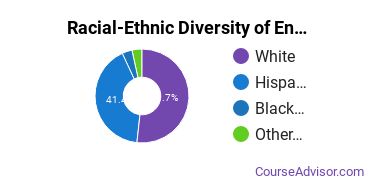Engineering Technologies at The University of Texas of the Permian Basin
Every engineering technologies school has its own distinct culture and strengths. We've pulled together some statistics and other details to help you see how the engineering tech program at The University of Texas of the Permian Basin stacks up to those at other schools.UT Permian Basin is located in Odessa, Texas and has a total student population of 5,530.
Want to know more about the career opportunities in this field? Check out the Careers in Engineering Technologies section at the bottom of this page.
UT Permian Basin Engineering Technologies Degrees Available
- Basic Certificate in Engineering Tech (Less Than 1 Year)
- Bachelor’s Degree in Engineering Tech
Online Classes Are Available at UT Permian Basin
Don't have the time or the flexibility in your schedule to take traditional classes? Online courses may be the perfect solution for you. They allow independent learners to study when and where they want to while offering the rigor of in-person classes.
UT Permian Basin does offer online education options in engineering tech for the following degree levels for those interested in distance learning:
UT Permian Basin Engineering Technologies Rankings
The engineering tech major at UT Permian Basin is not ranked on College Factual’s Best Colleges and Universities for Engineering Technologies. This could be for a number of reasons, such as not having enough data on the major or school to make an accurate assessment of its quality.
Engineering Tech Student Demographics at UT Permian Basin
Take a look at the following statistics related to the make-up of the engineering tech majors at The University of Texas of the Permian Basin.
UT Permian Basin Engineering Technologies Bachelor’s Program

About 57% of those who receive a bachelor's degree in engineering tech at UT Permian Basin are white. This is typical for this degree on the nationwide level. Prospective students may be interested in knowing that this school graduates 7% more racial-ethnic minorities in its engineering tech bachelor's program than the national average.*
The following table and chart show the race/ethnicity for students who recently graduated from The University of Texas of the Permian Basin with a bachelor's in engineering tech.

| Race/Ethnicity | Number of Students |
|---|---|
| Asian | 0 |
| Black or African American | 0 |
| Hispanic or Latino | 8 |
| White | 12 |
| International Students | 0 |
| Other Races/Ethnicities | 1 |
Concentrations Within Engineering Technologies
If you plan to be a engineering tech major, you may want to focus your studies on one of the following concentrations. The completion numbers here include all graduates who receive any type of degree in this field from The University of Texas of the Permian Basin. Some of these focus areas may not be available for your degree level.
| Concentration | Annual Degrees Awarded |
|---|---|
| Industrial Production Technology | 29 |
Related Majors
Careers That Engineering Tech Grads May Go Into
A degree in engineering tech can lead to the following careers. Since job numbers and average salaries can vary by geographic location, we have only included the numbers for TX, the home state for The University of Texas of the Permian Basin.
| Occupation | Jobs in TX | Average Salary in TX |
|---|---|---|
| Software Applications Developers | 71,260 | $108,760 |
| Inspectors, Testers, Sorters, Samplers, and Weighers | 54,090 | $42,500 |
| Automotive Service Technicians and Mechanics | 50,500 | $44,260 |
| Welders, Cutters, Solderers, and Brazers | 50,120 | $46,140 |
| Construction Managers | 29,620 | $98,420 |
References
*The racial-ethnic minorities count is calculated by taking the total number of students and subtracting white students, international students, and students whose race/ethnicity was unknown. This number is then divided by the total number of students at the school to obtain the racial-ethnic minorities percentage.
- College Factual
- National Center for Education Statistics
- O*NET Online
- Image Credit: By Billy Hathorn under License
More about our data sources and methodologies.
